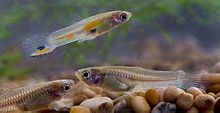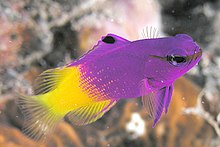Ovalentaria
| Ovalentaria | ||||||||||||
|---|---|---|---|---|---|---|---|---|---|---|---|---|

Breeding real clownfish . |
||||||||||||
| Systematics | ||||||||||||
|
||||||||||||
| Scientific name | ||||||||||||
| Ovalentaria | ||||||||||||
| Smith & Near , 2012 |
The ovalentaria ( Lat .: "Ova" = eggs, "lenta" = sticky or tough) are a species-rich fish taxon (a systematic group) from the group of perch relatives (Percomorphaceae). The ovalentaria include large groups of tropical freshwater fish such as cichlids and toothfish , inhabitants of the coral reefs ( damselfish & mucous fish species ) and taxa, which include marine fish as well as brackish and freshwater fish ( glass perch , mullet and earfish relatives ). The authors of the taxon, which was only established in 2012, are William Leo Smith from the Field Museum of Natural History and Thomas J. Near from the Peabody Museum of Natural History . The taxon includes over 4800 species in 40 families, that is 27% of the perch relatives and 16% of all fish species from the class of the ray fins (Acanthopterygii). The close relationship of these outwardly different groups is based on molecular biological investigations and is morphologically supported only by features on the eggs of the animals.
The monophyly of parts of the ovalentaria has been identified in previous phylogenetic studies, but none of these studies included all taxa of this clade .
A group of ichthyologists from the Muséum national d'histoire naturelle in Paris came the furthest , who identified a kinship group with a similar composition as the Ovalentaria and proposed to form a new order, which they named "Stiassnyiformes" in honor of the curator at the Department of Ichthyology at the American Museum of Natural History Melanie Stiassny , who already suspected in 1993 that the mullets are related to damselfish and guppies . However, they dispensed with a formal initial description and did not take into account the principle of biological ranks , which means that one order (e.g. Cyprinodontiformes) cannot belong to another order.
definition
The stiassnyiformes are a node-based Taxon (node-based definition), the most recent common ancestor of Ambassis urotaenia , Mugil cephalus , Embiotoca lateralis , Pseudochromis fridmani , northern clingfish , Gillellus semicinctus , Polycentrus schomburgkii , Pholidichthys leucotaenia , cichla temensis , brook silverside , Gambusia affinis and Oryzias latipes as well as all descendants of this ancestor.
features
A characteristic feature of ovalentaria are eggs that sink to the bottom and are attached to the seed opening (micropyle) with adhesive cell filaments. In five taxa of stiassnyiformes in the surf perch , the Zenarchopteridae , the Hochlandkärpflingen , the live-bearing tooth carp and some scaly blennies , it came to the development of Viviparie (lat .: "viviparus" viviparous =). In these cases, viviparia must have developed secondarily and independently of one another. In others, pelagic eggs developed secondary ( flying fish and some garfish ), or the adhesive threads were lost again (in the mullets and sea bass). Intensive brood care can be found in many taxa within the ovalentaria (e.g. in the cichlids and Pholidichthys ).
In addition, many species of ovalentaria share some of the following characteristics that cannot be used to diagnose the entire clade, but can be used for important lineages within the ovalentaria.
- Loss of interarcual cartilage, a cartilage between epibranchial I and pharyngobranchial II (bones of the branchial arch skeleton).
- Loss of neural processes (supraneuralia).
- a decreased number of pharyngobranchials.
- a reduced number of Branchiostegal rays .
- the fusion of some parts of the caudal fin velcro.
Systematics

The ovalentaria are in a sister group relationship to a clade of carangaria ( mackerel relatives and flatfish ) and anabantaria ( labyrinth fish , snakehead fish and gill-slit fish ). All three taxa together are the sister group of the Eupercaria , to which among others the armfinch , the puffer fish relatives and the perch-like belong.
The following cladogram shows the relationships of all taxa belonging to the ovalentaria:
| Ovalentaria |
|
||||||||||||||||||||||||||||||||||||||||||||||||||||||||||||||||||||||||||||||||||||||||||||||||
|
|
literature
- Peter C. Wainwright, W. Leo Smith, Samantha A. Price, Kevin L. Tang, John S. Sparks, Lara A. Ferry, Kristen L. Kuhn, Ron I. Eytan, Thomas J. Near: The Evolution of Pharyngognathy: A Phylogenetic and Functional Appraisal of the Pharyngeal Jaw Key Innovation in Labroid fishes and Beyond. In: Syst Biol. 2012. doi: 10.1093 / sysbio / sys060
- Ricardo Betancur-R., Richard E. Broughton, Edward O. Wiley, Kent Carpenter, J. Andrés López, Chenhong Li, Nancy I. Holcroft, Dahiana Arcila, Millicent Sanciangco, James C Cureton II, Feifei Zhang, Thaddaeus Buser, Matthew A. Campbell, Jesus A Ballesteros, Adela Roa-Varon, Stuart Willis, W. Calvin Borden, Thaine Rowley, Paulette C. Reneau, Daniel J. Hough, Guoqing Lu, Terry Grande, Gloria Arratia, Guillermo Ortí: The Tree of Life and a New Classification of Bony Fishes. In: PLOS Currents Tree of Life. 18th Apr 2013 [last modified: 2013 Apr 23]. Edition 1. doi: 10.1371 / currents.tol.53ba26640df0ccaee75bb165c8c26288 , (PDF)
- Thomas J. Near, Alex Dornburg, Ron I. Eytan, Benjamin P. Keck, W. Leo Smith, Kristen L. Kuhn, Jon A. Moore, Samantha A. Price, Frank T. Burbrink, Matt Friedman, Peter C. Wainwright : Phylogeny and tempo of diversification in the superradiation of spiny-rayed fishes. In: PNAS. July 2013. doi: 10.1073 / pnas.1304661110 , PDF
Individual evidence
- ^ William Leo Smith, Ward C. Wheeler: Polyphyly of the mail-cheeked fishes (Teleostei: Scorpaeniformes): evidence from mitochondrial and nuclear sequence data. In: Molecular Phylogenetics and Evolution. Volume 32, Issue 2, August 2004, pp. 627-646. doi: 10.1016 / j.ympev.2004.02.006 .
- ↑ DH Setiamarga, M. Miya, Y. Yamanoue, K. Mabuchi, TP Satoh, JG Inoue, M. Nishida: Interrelationships of Atherinomorpha (medakas, flyingfishes, killifishes, silversides, and their relatives): The first evidence based on whole mitogenome sequences. In: Molecular Phylogenetics and Evolution. Volume 49, Issue 2, November 2008, pp. 598-605. doi: 10.1016 / j.ympev.2008.08.008
- ↑ Blaise Li, Agnès Dettaï, Corinne Cruaud, Arnaud Couloux, Martine Desoutter-Meniger, Guillaume Lecointre: RNF213, a new nuclear marker for acanthomorph phylogeny. In: Molecular Phylogenetics and Evolution. Volume 50, Issue 2, February 2009, pp. 345-363. doi: 10.1016 / j.ympev.2008.11.013
- ↑ American Museum of Natural History AMNH scientists honored with an array of scientific names
- ↑ Melanie LJ Stiassny: What are Gray Mullets? In: Bulletin of Marine Science. Volume 52, Number 1, January 1993, pp. 197-219. (Abstract)
- ↑ Ellen Thaler : Eel gobies and their reproduction in the aquarium. In: Coral. No. 39, 2006.
- ↑ W. freshness, L. Gesset: Mysterious Aalgrundeln. In: DATZ . Volume 59, No. 1


